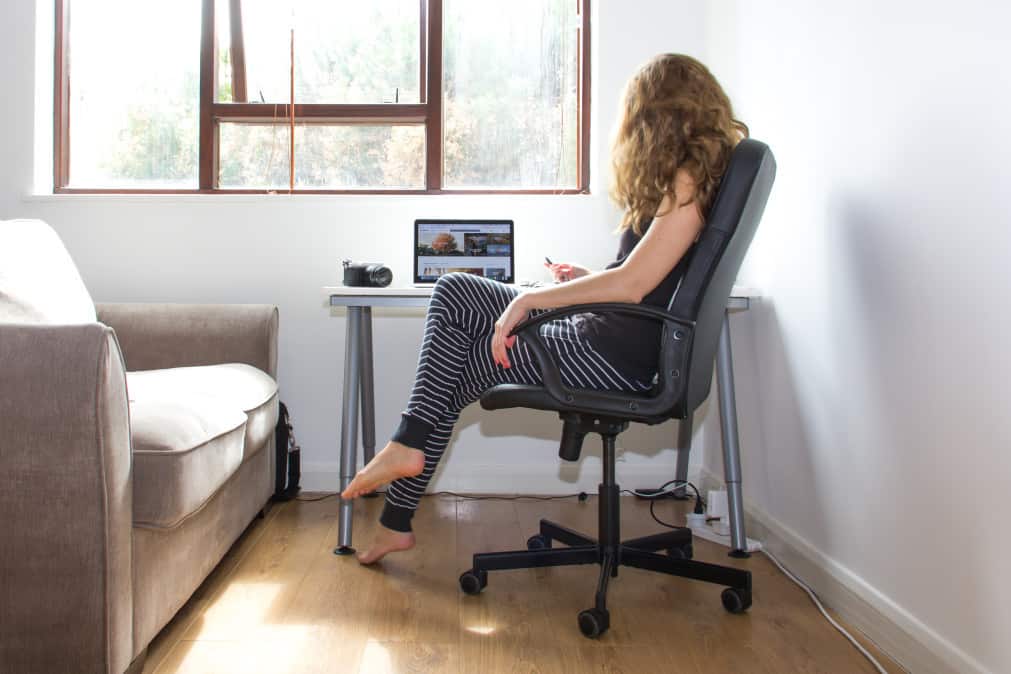Are you stuck sitting all day long for work? Starting to notice a few aches and pains?
The average American adult sits for a whopping 6.5 hours a day. And if you’re sitting that long, it’d be a miracle if you aren’t feeling a few kinks and pains at the end of your day.
More specifically, your hips are stuck in a flexed position throughout this entire duration. Undeniably, this can pose some issues, such as recurring and chronic hip pain and more. And yes, this can absolutely spread to the rest of your body. After all, everything is connected!
You might not only end up with a bit of stiffness in your hips, but you may also experience the dreaded lower back pain.
The good news: You can do something about it.
In this article, we’re going to outline exactly how you can prevent hip pain during the workday. Let’s get to it.
Stiff Hips? What’s Going On?

Nah, it’s not because you’re aging at an accelerated pace. Let’s knock that one out of the park here. Your hips are stiff because they’ve been stuck in the same position for hours on end. If you were to place any body part in the same position for an extended duration, it’s likely you’d feel it.
When you’re sitting, your hips are in a flexed position. This leaves your hip flexor muscles, a muscle group located on the front of your hips, at their shortest length for long durations. The body is a very adaptable machine.
This means that it adapts to this shortened length, as well as somewhat takes on the ‘if you don’t use it, you lose it’ mentality. Your hips become weak when you’re not using them for a large majority of the day.
In addition, your hamstrings on the back of the thigh also become shortened and weak in a typical sitting position. When these muscles or your hip flexors become tight, they can pull on your pelvis, which may cause issues in the lower spine. This is why many sedentary individuals end up with back pain.
The necessary muscles to prevent this are weak, and then other muscles are tight, creating problems that often arise as aches and pains.
So, how can you prevent this? What can you do to lower your risk of developing chronic pain in your hips?
3 Tips and Tricks to Prevent Hip Pain While You Work
There are various ways you can stop pain before it happens. And generally, it doesn’t take much effort. If anything, it may only require a few minutes out of your day or potentially some planning on your part to ensure your office set-up is ergonomically-friendly. Here are our top tips and tricks.
#1. Check Your Office Set-Up

And how you sit!
You want your back straight, and your feet flat on the ground with your knees bent at 90 degrees. You don’t want to be crossing your legs, hunching over, or leaning to any one side. Proper alignment and posture are key here!
Alternatively, you may want to invest in a standing desk – or a desk that does both. This can allow you to sit for a little bit, then stand for a little bit, which helps counterbalance any ill effects of either situation.
No products found.
Related: Review some of the best office chairs for hip pain.
#2. Take Breaks
You’ve probably heard this one before. Get up and move every hour or two. Shake it out, walk it out, or stretch it out. Your body will thank you for moving a little bit and not sitting in the same spot for hours on end.
This can also get your blood flowing, which can help alleviate any stiffness that has developed over the last hour or two. Further, adequate blood flow can promote healing, which can help relieve any existing pain.
#3. Perform Daily Hip Stretches
Since sitting all day might not be entirely avoidable, especially if it’s for work, you can take other actions to lessen the blow. Taking a few minutes each day to stretch out your hips can help improve flexibility, mobility, and function.
Try these stretches to get started:
The Hip Flexor Stretch
The hip flexors are the small muscles located in front of your thighs and hips. They help bring your leg up and forward. And they get very tight when sitting. So, let’s stretch them out.
Grab a cushion or yoga mat (this will create a softer area to rest your knee on during this stretch). Place your left knee on the cushion or mat. And then step your right foot forward, so that your right knee is bent at 90 degrees and you’re situated in a low lunge. Gently lean slightly forward or until you feel a stretch along the front of your left hip. Hold here for 20-30 seconds, then switch sides.
The Hamstring Stretch
This one you can do in your chair. However, if your chair has wheels, you may want to trade it out for a more sturdy option so that you don’t risk falling off. Sit on the edge of your chair and straighten your right leg out in front of you.
Plant your right heel on the ground. Then, slowly lean forward toward your right leg. You should feel a stretch in the back of your right thigh. Hold here for 20-30 seconds, then switch legs.
The Piriformis Stretch
For the piriformis stretch, you will need a comfortable surface to lay on, such as a yoga mat.
Now, the piriformis muscle is a tiny muscle located in the buttocks.
Yet, this small muscle can cause big problems, including sciatic nerve pain down the legs and lower back issues.
And these issues often arise when the piriformis muscle becomes tight or spasms.
So, let’s stretch this teeny but finicky muscle out! Lay on your back with your knees bent and your feet flat on the ground. Cross your right foot across your left thigh. Reach through and grab your left leg with both hands and pull your legs toward your chest.
You should feel a stretch through your right piriformis.
Hold for 20-30 seconds, then switch sides.
The Quad Stretch
The quadriceps are located in the front of the thighs. Since they are situated close to the hips, it can’t hurt to show them a little love. This stretch is another easy one.
Stand near a table or wall – any sturdy object that will provide support if you lose your balance. Bend your right leg, bringing your right foot up toward your right buttocks. Hold your right foot with your right hand.
Ensure your thighs remain parallel.
Your knee shouldn’t jut out in front of the other. From there, you should feel a gentle stretch in the front of your right thigh. Once you do, hold here for 20-30 seconds, then, again, switch legs.
Related: If you’re using a standing desk, check out some of these exercises.
Get Your Work Done Without Pain Standing in Your Way!
It doesn’t require much more work or much effort. All you need are a few minutes out of your day to stretch or to move at set intervals.
Hip pain and back pain don’t have to be in your future. Gain back the time you’d spend in pain now and use our tips to your advantage. And if you need a good ergonomic chair or a standing desk, check out what we recommend.
Our goal is to give you the best options on the market so that you can have the tools you need to prevent pain before it happens.